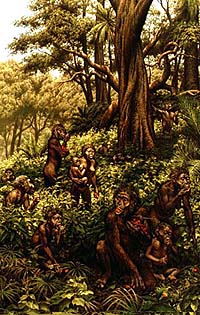




"While A. afarensis walked upright like a modern human, they had long arms. The ratio of upper arm bone (humerus) to upper leg bone (femur) in A. afarensis is virtually the same as that of a Chimpanzee -->95%. The ratio of upper arm to upper leg in a modern human is around 70%."
"Sexual dimorphism in terms of body size is quite pronounced in this species [?], with males approximately twice as large in bulk as females and considerably taller. In mammals, this large size disparity in the sexes usually means that males compete for mating privileges with females. However, the large fighting canines found in male gorillas, chimps, and baboons are absent in A. afarensis, so we cannot draw clear inferences about their social behavior."

"Thus far, fossil remains of over 300 individuals of A. afarensis have been discovered. To date, all the remains of this species have been found in the Hadar region of Ethiopia, part of the Rift Valley of east Africa. 'Lucy', the most complete find, was discovered in 1974. Hominid footprints 3.5 million years old have been found at Laetoli in Tanzania. Scientists estimate that A. afarensis lived from approximately 4 million years ago (or earlier) to around 2.7 millions years ago."
"For more information on Australopithecus afarensis see Donald Johanson and Maitland Edey, Lucy: The Beginnings of Humankind (1981); or Donald Johanson and James Shreeve, Lucy's Child: The Discovery of a Human Ancestor (William Morrow & Co., New York: 1989), Donald Johanson, Lenora Johanson and Blake Edgar, Ancestors: In Search of Human Origins (Villard Books: New York, 1994)."
MORE (Lucy’s face)
Washington State University